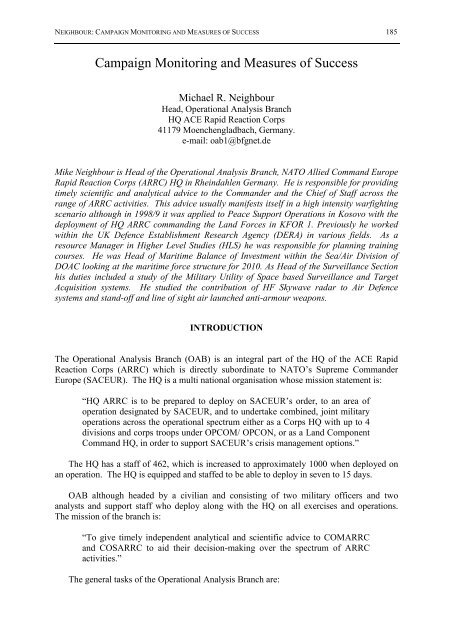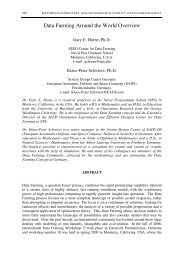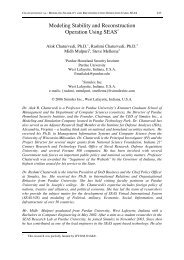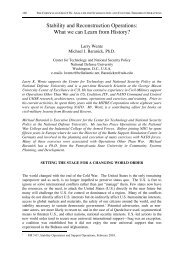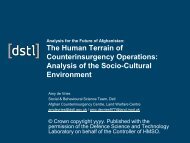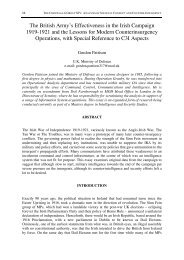CAMPAIGN MONITORING - Cornwallis Group
CAMPAIGN MONITORING - Cornwallis Group
CAMPAIGN MONITORING - Cornwallis Group
Create successful ePaper yourself
Turn your PDF publications into a flip-book with our unique Google optimized e-Paper software.
NEIGHBOUR: <strong>CAMPAIGN</strong> <strong>MONITORING</strong> AND MEASURES OF SUCCESS 185Campaign Monitoring and Measures of SuccessMichael R. NeighbourHead, Operational Analysis BranchHQ ACE Rapid Reaction Corps41179 Moenchengladbach, Germany.e-mail: oab1@bfgnet.deMike Neighbour is Head of the Operational Analysis Branch, NATO Allied Command EuropeRapid Reaction Corps (ARRC) HQ in Rheindahlen Germany. He is responsible for providingtimely scientific and analytical advice to the Commander and the Chief of Staff across therange of ARRC activities. This advice usually manifests itself in a high intensity warfightingscenario although in 1998/9 it was applied to Peace Support Operations in Kosovo with thedeployment of HQ ARRC commanding the Land Forces in KFOR 1. Previously he workedwithin the UK Defence Establishment Research Agency (DERA) in various fields. As aresource Manager in Higher Level Studies (HLS) he was responsible for planning trainingcourses. He was Head of Maritime Balance of Investment within the Sea/Air Division ofDOAC looking at the maritime force structure for 2010. As Head of the Surveillance Sectionhis duties included a study of the Military Utility of Space based Surveillance and TargetAcquisition systems. He studied the contribution of HF Skywave radar to Air Defencesystems and stand-off and line of sight air launched anti-armour weapons.INTRODUCTIONThe Operational Analysis Branch (OAB) is an integral part of the HQ of the ACE RapidReaction Corps (ARRC) which is directly subordinate to NATO’s Supreme CommanderEurope (SACEUR). The HQ is a multi national organisation whose mission statement is:“HQ ARRC is to be prepared to deploy on SACEUR’s order, to an area ofoperation designated by SACEUR, and to undertake combined, joint militaryoperations across the operational spectrum either as a Corps HQ with up to 4divisions and corps troops under OPCOM/ OPCON, or as a Land ComponentCommand HQ, in order to support SACEUR’s crisis management options.”The HQ has a staff of 462, which is increased to approximately 1000 when deployed onan operation. The HQ is equipped and staffed to be able to deploy in seven to 15 days.OAB although headed by a civilian and consisting of two military officers and twoanalysts and support staff who deploy along with the HQ on all exercises and operations.The mission of the branch is:“To give timely independent analytical and scientific advice to COMARRCand COSARRC to aid their decision-making over the spectrum of ARRCactivities.”The general tasks of the Operational Analysis Branch are:
186 THE CORNWALLIS GROUP VI: ANALYSIS FOR ASSESSMENT, EVALUATION AND CRISIS MANAGEMENT1. Support to HQ Planning. Covering: Contingency planning, conceptdevelopment and Force mix issues.2. Model/Technique Development. Ensure that OAB has relevant tools andinformation to support tasks.3. Technology Demonstrators. Military Staff planning tool development.4. General Science and Technology. Liaison between ARRC and scientificcommunity to ensure HQ ARRC has access to latest developments.HQ ARRC HISTORYHQ ARRC has had a short history having been activated in 1992 a year after a working groupwas set up to consider its formation. The HQ has been deployed twice first on OperationFirm Endeavour in Bosnia and lately on Operation Joint Guardian to the Former YugoslavRepublic of Macedonia (FYROM) and KosovoOperation Firm Endeavour saw the HQ deploy to Bosnia and Herzegovina to act as theLand Component HQ for the Dayton peace accord Implementation Force (IFOR) fromDecember 1995 to November 1996. The mission given to the Commander of HQ ARRC(COMARRC) was:“On order, COMARRC is to assume command of the AO of B-H andcomplete the military task of the peace agreement as defined by the NATOAtlantic Council. He is to control and secure the withdrawal of the UN forcesnot transferred to the IFOR. He is to be prepared to execute the emergencywithdrawal of the UNCRO forces.”Operation Joint Guardian was in two parts. The first to FYROM started inFebruary/March 1999 the mission from SACUR to COMARRC was:“Ensure force protection by means of an integrated defensive posture againstattacks on HATO forces and forces formerly part of UNPREDEP deployed inFYROM.Within means and capabilities, support UNHCR and FYROM authoritieshumanitarian assistance to refugees.Be prepared to establish KFOR to implement and, when necessary, enforcecompliance with the military provisions of an Interim Agreement.”The HQ deployed into Kosovo on the 12 June 1999 and returned to home base on 20October 1999. The revised mission to cover operations in Kosovo as at 20 July 1999 was:“KFOR, in accordance with UNSCR 1244, is to:
NEIGHBOUR: <strong>CAMPAIGN</strong> <strong>MONITORING</strong> AND MEASURES OF SUCCESS 187a. Monitor, verify and, when necessary enforce compliance with theconditions of the Military Technical Agreement (MTA), and theUCK Undertaking.b. Establish and maintain a secure environment, including publicsafety and order.c. Provide assistance to the United Nations Mission in Kosovo(UNMIK), including core civil functions until transferred in orderto facilitate peace and stability in Kosovo.”<strong>CAMPAIGN</strong> <strong>MONITORING</strong>During both missions OAB became involved in what has been termed Campaign Monitoring,the intention being to track and give numerate indicators to the progress of the mission.Looking at the mission statements and commanders intent for the two missions completedby HQ ARRC three common elements, which are amenable come out they, are:• The need to track the compliance of the various factions with agreements theyhave signed.• The need to establish the degree to which stability (Security is often used asan alternative) has been achieved.• The need to establish what constitutes peace (normality is perhaps a betterdescriptor as peace is subjective where as normality refers to the normal statefor the region) in the region and to what extent that applies in the area ofoperations.In this paper these are the three elements which I will consider in more depth in order tomonitor a campaign as has been seen all three relate to role undertaken by the HQ in both itsdeployments.COMPLIANCEIn order to have a peace support operation there will be some form of agreement between thefactions in dispute. This can be of the nature of agreements prior to the forces beingdeployed into the Balkans, or indeed the Peace support force may have been in conflict itselfprior to assuming a peace support role.In either case there will be an agreement to cease hostilities, in Bosnia there was theDayton agreement, with its Military annex and in Kosovo there were two documents theMilitary Undertaking signed by the Yugoslavian Army and the Undertaking signed with theUCK. These agreements will form the basis of any compliance reporting, they are thestandard by which we must measure willingness of the factions involved to stand by theiragreement. The compliance report must be; accurate, based upon fact, having an audit trailback to an agreed document and timely.
188 THE CORNWALLIS GROUP VI: ANALYSIS FOR ASSESSMENT, EVALUATION AND CRISIS MANAGEMENTConsidering agreements in general which are associated with Peace Support Missionsthey can consist of four elements:• Separation, this will be an agreement to confine forces to specific areas for thepurpose of removing the potential for conflict. An example of this would beCyprus.• Behavioural, this will be an agreement to refrain from certain activities, bothmilitary and civil. For instance the requirement to cease hostilities is a prerequisitebut also may include an agreement not to undertake the activities of acivil administration, police and emergency services.• Transformation, the requirement to change the nature of an organisation forinstance from a gorilla army to a regular army, or a civil defence force.• Disbandment, the requirement to totally disband such that the organisationceases to exist.Each of these four elements will have measurable components for instance Dayton calledfor:“The parties must complete withdrawal of forces behind a zone of separationof approximately 4km within an agreed period. Special provision relates toSarajevo and Gorazde.As a confidence-building measure, the parties agree to withdraw heavyweapons and forces to cantonment/barracks areas within an agreed period andto demobilise forces which cannot be accommodated in those areas.”In both the above paragraphs there are measurable elements. The first paragraph is aboutseparation. The situation in what appears to a clear case of separation can be confusing. Thecrossing of a boundary by military formation will be a clear violation. However, the crossingof the boundary by a member of the armed forces not in uniform could be an honest mistakeor not it is only by keeping track of all incidence we can see if there is an increase or not. Itis interesting to note that in Bosnia most Compliance violations were due to:• Localised problems.• Former Warring Factions incompetence.• Genuine inability to comply.The situation in Kosovo was very different there was not one set of agreements coveringboth parties but individual agreements signed with the two main parties. The Agreementsboth with the UCK and with the VJ were negotiated by General Jackson the Commander ofKFOR and not the more normal approach of being in the political arena. The agreements hadelements of separation, the phased withdrawal of the VJ, behaviour and disbandment (it couldbe argued that the UCK was transformed into the Kosovo Protection Corps). This isillustrated by the following extract from the UCK undertaking:
NEIGHBOUR: <strong>CAMPAIGN</strong> <strong>MONITORING</strong> AND MEASURES OF SUCCESS 189“The UCK agrees to comply with all of the obligations of this Undertakingand to ensure that with immediate effect all UCK forces in Kosovo and inneighbouring countries will observe the provisions of this Undertaking, willrefrain from all hostile or provocative acts, hostile intent and freeze militarymovement in either direction across international borders or theboundary between Kosovo and other parts of the FRY, or any otheractions inconsistent with the spirit of UNSCR 1244. The UCK in Kosovoagree to commit themselves publicly to demilitarise in accordance withparagraphs 22 and 23, refrain from activities which jeopardise the safety ofinternational governmental and non-governmental personnel includingKFOR, and to facilitate the deployment and operation of KFOR.”The section in bold is separation, that in italics behavioural and that underlineddisbandment.The different elements into which agreements can be dived will draw upon different datasources for compliance monitoring along the following lines:• Separation: Surveillance reported through the intelligence G2 or Operations(G3) side of the HQ.• Behavioural: Monitoring of public life through Media analysis, and surveys.• Disbandment: Intelligence gathering as well monitoring of public life throughMedia analysis, and surveys.• Transformation: As for disbandment.While the above categories helps in identifying the range of possible data required foranalysis of compliance in order to monitor compliance a more detailed approach is required.A detailed analysis of any agreement signed to bring about an end to hostilities reveals a largenumber of conditions the signatures agree to. By going through any agreement andidentifying all points which have been agreed a large number of agreed points are invariableproduced. The number of agreed points is such that it is impractical to keep tabs on all thepoints, thus the list has to be grouped into categories in order to make it manageable. Ananalysis of KFOR and Dayton agreements has identified that all points can be placed into thefollowing twelve categories:1. Cessation of Hostilities.2. Location of forces.3. Time Lines.4. Cooperation with Military.5. Cooperation with civil presence.6. De-Militarisation.
Fre que ncy190 THE CORNWALLIS GROUP VI: ANALYSIS FOR ASSESSMENT, EVALUATION AND CRISIS MANAGEMENT7. Notification of Status.8. Minefields, etc.9. Repatriation.10. Response to enforcement.11. Adherence to procedures.12. Declaration and Communications.A manageable compliance report can then be produced using these categories, the KFORexample below shows how this can be done.2018161412COMPLIANCE EXAMPLE: IFOR10The analysis in support of a separation is illustrated in Figure 1, which indicates the numberof violation of the zone of separation (ZOS) in Bosnia and Hertzogavina. The trend analysispresented in Figure 1 helps to identify long term trends from which variations can be testedstatically to see if any trend is significant.864Total ZOS Violations VRS BIH HVO ??ZOS Viola tions : D+90 to D+120Total ZOS Violations VRS BIH HVO ??5 4 1 D+90 - D+94 17 11 2 1 320D+95 - D+99 15 4 11 0 03 2 1 D+100 - D+104 3 1 2 Total Z OS 0V iolations 04182 1 1 D+105 - D+109 6 3 1 V RS 2 05 3 2 D+110 - D+114 4 2 2BIH0 01161 D+115 - D120 2 0 2HV O0 0??10 3 7 47 21 20 3 3314Log. (Total Z OS V iolations )1 21 1Log. (V RS)2 12 1 1Log. (BIH)Log. (HV O)20D+90 - D+941 10181 13 1 1 161 1R 2 = 0.8219R 2 = 0.8153R 2 = 0.0981R 2 = 0.03481411 11 212 0 1 1D+90 - D+94 D+95 - D+99 D+100 - D+104 D+105 - D+109 D+110 - D+114 D+115 - D120Pe riod1 1Figure 1: Violations of the zone of separation in Bosnia and Hertzogavina.
NEIGHBOUR: <strong>CAMPAIGN</strong> <strong>MONITORING</strong> AND MEASURES OF SUCCESS 191COMPLIANCE EXAMPLE: KFORIn order to measure compliance in Kosovo UNSCR 1244, the Military Technical Agreementsigned by KFOR and VJ and the Undertaking signed by KFOR and the UCK were examined.A detailed analysis of the UCK Undertaking yielded 147 specific items for each item animplied compliance and a KFOR task was identified. Two such tasks are shown below.Ser Ref Compliance Requirement Implied Compliance KFOR Task93. UCK/4 The UCK in Kosovoagree to committhemselves publicly todemilitarise inaccordance withparagraphs 22 and 23Sound-bites whichundermine theUndertaking are noncompliantMonitor UCKmedia/pressstatements94. UCK/4 The UCK in Kosovoagree to committhemselves publicly tofacilitate the deploymentand operation of KFORSound-bites whichundermine theUndertaking are noncompliantMonitor UCKmedia/pressstatementsThe 147 tasks to monitor and report would have been unwieldy and consequently theywere grouped into 10 categories which are listed below, each is but into the appropriate boxfor the different element of an agreement. In this table, the number in brackets indicates thenumber of tasksSeparation Behavioural Disbandment TransformationLocation of Forces(11)Minefields etc (8)Cessation ofHostilities (13)Adherence toprocedures (17)Co-operation withKFOR (25)Co-operation withcivil presence (9)De-Militarisation(8)Decarations &Communications ofMTA/Understanding (9)Response toenforcement (18)Timelines(29)Figure 2 shows a specific example of an incident report. This report was then put in anincidents data base. Data from media analysis report as well as traditional military reportingchain were entered in the database. Using the incidence database a weekly compliance reportwas drawn upThe weekly compliance report consisted of an annex containing all the complianceincidence sorted into the 11 categories. For each compliance category a summary report wasproduced as shown in Figure 2 top left hand side. A summary report for all categories wasproduced an example is illustrated in the center of Figure 2. For each of the 11 categories asingle comment was recorded i.e. compliant. Next to this is a colored box, red green oryellow to indicate non-compliant, compliant or mixed situation, the 3 rd box then indicates thetrend, arrow up for a deteriorating situation down for an improving situation and level for no
192 THE CORNWALLIS GROUP VI: ANALYSIS FOR ASSESSMENT, EVALUATION AND CRISIS MANAGEMENTchange. The example in Figure 2 is in the category of declarations and communications andwe can see the positive comment made by Thaci has come through to contribute to a green inthe final assessment on Declarations and Communications.OAB COMPLIANCE ASSESSMENT OF UCK AS AT 032359B SEP 99 – K+741. General. There has been a significant decrease in the number of non-compliantissues that can be attributed directly to the UCK/PU. This is can be accounted for byimproved compliance from the UCK/PU, but there are other factors to consider. TheUNIP are now taking responsibility for investigating incidents at an earlier stage. Thiscauses loss of OAB visibility on the final outcome of an investigation and the subsequentapportionment of blame. In addition the connection between organised crime and crimecommitted by UCK/PU members is becoming harder to define.…8. Declarations & Communication of Undertaking. The UCK leadership has publiclydeclared its compliance and does seem genuinely eager to co-operate with KFOR. Thesituation in the OZs is less clear…Compliant13. Summary Table. The summary table is attached as Annex A.Ser Compliance Category Assessment Text Graphic Trend1 Cessation of Hostilities Minor non-compliance -2 Location of Forces Compliant 3 De-Militarisation Minor non-compliance -4 Adherence to Procedure Minor non-compliance -5 Co-operation with KFOR Minor non-compliance - 6 Co-operation with Civil Presence Non-compliant 7 Declarations and Communication Compliant 8 Minefields obstacles and Checkpoints Compliant 9 Response to enforcement Compliant 10 Authority and General Provisions Compliant 11 Timelines Minor non-compliance -“ ” indicates deterioration in compliance,"" indicates an improvement.Figure 2: Kosovo Compliance example.Figure 3 shows a compilation of the weekly executive summary indicators forcompliance, showing the improving trend during the disbandment period of the UCK (theKosovo liberation army). This diagram was part of the final report on compliance producedafter the disbandment of the UCK.UCK COMPLIANCE K+12 TO K+903 Jul 99 10 Jul 99 17 Jul 99 20 Jul 99 1 Aug 99 8 Aug 99 21 Aug 99 28 Aug 99 4 Sep 99 11 Sep 99 19 Sep 99Ser Compliance Category K+12 K+19 K+26 K+29 K+41 K+48 K+61 K+68 K+75 K+81 K+901 Cessation of (23) - (16) - (23) - (23) - (8) - - - - -Hostilities(14)2 Location of Forces - (10) - (8) (5) - (9) (3) (2) 3 De-Militarisation - (10) - (1) - (1) (2) - (8) - (6) - - - - -4 Adherence to - (8) (13) (17) (19) (13) - - - - -Procedure(18)5 Cooperation with (5) (2) (4) (5) - (6) (6) - - -KFOR6 Cooperation with Civil (0) (1) - (1) (3) - (5) - (1) -Presence7 Declarations and (1) (1) (0) - (0) - (1) (0) Communication8 Minefields obstacles - (5) - (2) (1) - (5) - (3) - (3) - and Checkpoints9 Response to (0) (0) (0) (0) (0) (0) enforcement10 Authority and General (0) (0) (0) (0) (0) (0) Provisions11 Timelines (20) (13)(10)- (21) - (26) (22) - - - - -Figure 3: Summary of Kosovo Liberation Army disbandment monitoring.
NEIGHBOUR: <strong>CAMPAIGN</strong> <strong>MONITORING</strong> AND MEASURES OF SUCCESS 193STABILITYIn order for life to return to normal one of the first tasks is for the military (and or Police) toestablish a stable environment. The key indicators of stability are noted below.Serious Crime: While crime is pervasive through out society a very high level is anindication of the break down of acceptable standards in society. Tracking crime ratesindicate the return to normal, but at the high end also indicate the level to which stableenvironment has been created. Tracking crime rates is a standard task in all countries andrates per 100,000 are the standard. Relevant subcategories for a Peace Support Mission are:• Murder. An example from KFOR is shown in Figures 4, 5 and 6.• Looting. A KFOR example is shown in Figure 4.• Arson. A KFOR example is shown in Figure 4.• Crimes against the person.300250200150100MURDERARSONLOOTINGMURDERARSONLOOTING50019-Jun 26-Jun 3-Jul 10-Jul 17-Jul 24-Jul 31-Jul 7-Aug 14-Aug 21-Aug 28-Aug 4-SepWEEK ENDINGFigure 4: Kosovo reported incidence of Murder, Arson and Looting.War Crimes: When the ARRC deployed to both Bosnia and Kosovo there was no effectiveGovernment or police force, both function where temporarily being undertaken by themilitary. On the initial entry of Military Forces into both areas they are likely to be chargedwith helping document war crimes and preserve war crime sites, hence the following subcategories:• Recording. Figure 7 is an example from KFOR.• Guarding.
RATE PER 100,000 OF POPULATION PER ANNUMRATE PER 100,000 OF POPULATION PERANNUM194 THE CORNWALLIS GROUP VI: ANALYSIS FOR ASSESSMENT, EVALUATION AND CRISIS MANAGEMENT2001801601401201008060MURDER RATEWASHINGTONPRETORIAMOSCOWBERLIN4020019-Jun26-Jun3-Jul 10-Jul17-Jul24-Jul31-Jul7-Aug14-Aug21-Aug28-Aug4-SepWEEK ENDINGFigure 5: Kosovo murder rate.6005004003002001000SERBALBANIANKOSOVOWASHINGTONPRETORIAMOSCOWBERLINFigure 6: Kosovo murder rate for Serbs and Albanians.Forces Protection: Of particular importance to military commanders is the acceptance of thepeace keeping force. Not only are attacks against the force resulting in casualties of the forcea measure of stability but also the number of attacks against the force. While it is hoped thatthere will be no attacks against or casualties in the peace keeping force, a lower level ofstability is how the force is accepted. In order to monitor acceptance of patrols each patrolwill need to record in their patrol report the reception of the locals (for instance, friendly andsmiling, indifferent or verbally hostile).
NEIGHBOUR: <strong>CAMPAIGN</strong> <strong>MONITORING</strong> AND MEASURES OF SUCCESS 195• Casualties.• Attacks against the force. Figure 8 gives an example from KFOR.• Acceptance of Patrols.MASSGRAVESAs of 9 July 99• Reported• ConfirmedFigure 7: Kosovo location of reports of mass graves.Boarder/Boundary Control: Depending on the situation it is likely that the boarders of thearea will have to be secured either my military peace keeping force or some other body.Incidence of border violation both military and civil (smuggling for instance).Basic Need of Population: A key indicator of stability is the needs of the population in thefollowing catergories:• Shelter. What proportion of the local population has a roof over their head?Figure 9 is an example from KFOR derived from the Rapid VillageAssessment.• Food To what extent are the population being feed? Figure 11 gives anexample from IFOR drawn from OAB normality survey.• Water. Is drinking water available to the population and what is the standardof that water?
N U M BE R O F IN CID E N TS196 THE CORNWALLIS GROUP VI: ANALYSIS FOR ASSESSMENT, EVALUATION AND CRISIS MANAGEMENT18161412108M ortar A ttacksGrenade AttacksEngag em ents of KFO R64209999999919-06-03-07-17-07-31-07-9914-08-9928-08-9911-09-25-09-99W EE K EN D IN GFigure 8: Kosovo reports of Mortar attacks, Grenade attacks and engagements ofKFOR.Villages: 1977Assessed Villages: 1093 55%Houses: 145546Cat 1: 59877 41%Cat 2: 16393 11%Cat 3: 13189 9%Cat 4: 21341 15%Cat 5: 34746 24% Broken windows, door locksand hinges, roof tilesCut-off from electricity, waterCan be repairedUp to 30% roof damageLight shelling or bullet impacton wallsPartial fire damageCan be repairedOver 30% roof damageSevere fire damageNeed for replacement of floorsDoors and windows destroyedAll piping, wiring destroyedCan be repairedDestroyedNeeds reconstructionCannot be repairedFigure 9: Kosovo housing damage levels.
NEIGHBOUR: <strong>CAMPAIGN</strong> <strong>MONITORING</strong> AND MEASURES OF SUCCESS 197All Four Key Indicators availableOne Key Indicator missingTwo Key Indicators missingOnly One Key Indicator available.Figure 10: Food availability index to Figures 11, 12, and 13.Figure 11: Availabilty of key groceries in Bosnia and Hertzogavina.Return of DPRE. In any conflict there are likely to have been displaced persons or refugees,the rate of return should be monitored.NORMALITYThe ultimate objective of any peace support mission is to set the conditions for the area toreturn to normal. However normal is a subjective term and any recording of normality shouldbe against the pre-conflict norms of the society or the surrounding area. While the militarywill not be the prime agency for rebuilding normality, they will be responsible for settingconditions for the return of normality. In this area a great deal of the data to measure
Availab ilty198 THE CORNWALLIS GROUP VI: ANALYSIS FOR ASSESSMENT, EVALUATION AND CRISIS MANAGEMENTnormality is in the non-military domain and will require co-operation with a variety ofagencies. The following categories are examples of measures of normalityPublic Service: The following categories of restoration of public service can be monitored.The availability of the following categories of public life give an indication of normality. Inall categories the facilities should be available to all members of the community: OAB RapidVillage Assessment shows the feasibility of collecting this data.• Schools.• Universities.• Hospitals.• Transport.• Local Administration.• Water.• Power.Commercial: The commercial restoration of an area depends heavily on the securitysituation. In Bosnia this became a critical factor to track while in Kosovo the restoration wasso rapid that tracking was not extensively undertaken.• Food availability/Price. Figures 12, 13 and 14 show examples from KFORusing the Rapid Village Assessment, direct sampling was used in KFORA v ailab ility o f B as ic F o o d stu ff o v er T im e5 0%0 9-Jun -99 1 9 -Ju n -9 9 2 9-Jun -99 0 9 -Ju l-9 9 1 9-Jul-9 9 2 9 -Ju l-9 9 0 8-A ug -99 18 -A u g -9 9 2 8 -A ug -9 9 07 -S e p -9 9 1 7 -S ep -9 9W he at S u ga r M e at F ruit C offe eFigure 12: Availability of food in Kosovo.
De n arNEIGHBOUR: <strong>CAMPAIGN</strong> <strong>MONITORING</strong> AND MEASURES OF SUCCESS 199P rice s o v e r T im e25020015010050004-Jul-99 1 4-Jul-9 9 2 4-Jul-9 9 03-A ug-99 13-A ug-99 2 3-A u g-99 0 2-S e p-99 1 2-S e p-99 22 -S ep -9 9M ea t S ug ar W h eat F ru it C offeeFigure 13: Variation in food prices in Kosovo.Av aila bility p er O ps tin aLip l ja nS ti m ljeP e cG n ji la n eS u v a R e k aP ri z re nIs to kKl i n aG o raD ja k o v i c aD e c a n iP ris t i n aKo s o v s k a M it ro v i c aS t rp c eN o v o B rd oG l o g o v a cO ra h o v a cK a c a n i kS rb i c aZ v e c a n eKo s o v o P o ljeU ro s e v a cO b i li cKo s o v s k a Ka m e n i c aV u c it rnV it i n aLe p o s a v i cZ u b in P o to kP o d u je v o16% 12% 12% 4% 2%5% 5% 21% 0% 1 6 %29% 2 0 % 7% 5% 5%6% 8% 10% 1 0 % 6%8% 14% 27% 22% 5%14% 19% 16% 14% 9%44% 41% 5% 5% 3%37% 34% 21% 13% 1 3 %14% 14% 14% 14% 14%31% 6% 4 4 % 31% 6%53% 43% 3% 28% 0%43% 33% 19% 1 7 % 2 1 %44% 34% 41% 13% 22%57% 48% 13% 9% 0%33% 33% 3 3 % 33% 33%63% 68% 16% 11% 1 1 %31% 35% 25% 33% 19%43% 43% 3 0 % 19% 1 4 %58% 34% 50% 45% 5%33% 50% 50% 33% 33%42% 42% 50% 42% 2 5 %34% 32% 26% 37% 2 4 %81% 75% 31% 25% 19%4 1 % 50% 28% 53% 1 3 %61% 54% 55% 43% 41%46% 54% 5 4 % 49% 5 1 %86% 35% 8 0 % 1 6 % 7 8 %64% 45% 73% 45% 64%7 1 % 74% 7 4 % 73% 6 0 %WheatSugarFruitCoffeeMeatFigure 14: Geographical variation of food availability.• State of shops/factories.
percentage ofcultivated landland cover percentageland cover percentageland cover percentage200 THE CORNWALLIS GROUP VI: ANALYSIS FOR ASSESSMENT, EVALUATION AND CRISIS MANAGEMENT• Media.• Agriculture. Figure 15 shows a KFOR example.100%100%80%60%40%20%0%O th e rMo u n t a inG ra s s /H a yC o rn80%60%40%20%0%O th e rMo u n t a inG ra s s /H a yC o rn1997 1998 1999C e re a ls1997 1998 1999C e re a lsyearyear100%80%60%40%20%0%1998 1999O th e rMo u n ta inG ra s s /H a yC o rnC e re a ls100%80%60%40%20%0%1997 1998 1999yearO th e rMo u n t a inG ra s s /H a yC o rnC e re a lsyearFigure 15: Changes in Kosovo agriculture usage.Cultural:• Religious.• Cultural.Recreational:Legal:• Spectator.• Participation.• Police.• Judiciary.• Prisons.Rebuilding: The rebuilding of Kosovo was of particular concern and the military throughOAB conducted a joint survey the Rapid Village Assessment with the aid agencies lead bythe UNHCR. This survey became the cornerstone of KFOR knowledge of Kosovo.
Summary of Scores given to OpstinasNEIGHBOUR: <strong>CAMPAIGN</strong> <strong>MONITORING</strong> AND MEASURES OF SUCCESS 201• Housing.• Road/Rail infrastructure.Freedom of Movement:• Road traffic. Figure 16 show an example from IFOR, where freedom ofmovement was a particular issue.100%75%50%25%0%Feb Mar Apr May Jun Jul Aug Sep OctFigure 16: Traffic movement in Bosnia and Hertzogavina.MEASURES OF SUCESSMeasures associated with most of the above categories can be established and a number ofthese were measured by OAB in Bosnia and Kosovo shown in Figures 4 onwards.In order to demonstrate progress of a mission a simple summary graphic is required.Figure 17 is a fictional example. In this example we have four areas hence four columns inthe graphic, the colours indicate the level of normality.For all on the measures of success a predicted rate of recoverable can be estimated at thestart of the mission and subsequently the criteria can be compared with the estimate. Figure18 indicates a predicted rate of recovery that might be expected.This shows that we would expect compliance to be relatively short term improvements,stability changes in months and normality up to years. Following the discipline of thesemeasures would enable the military and international community to have a clear indication oftheir achievements.


